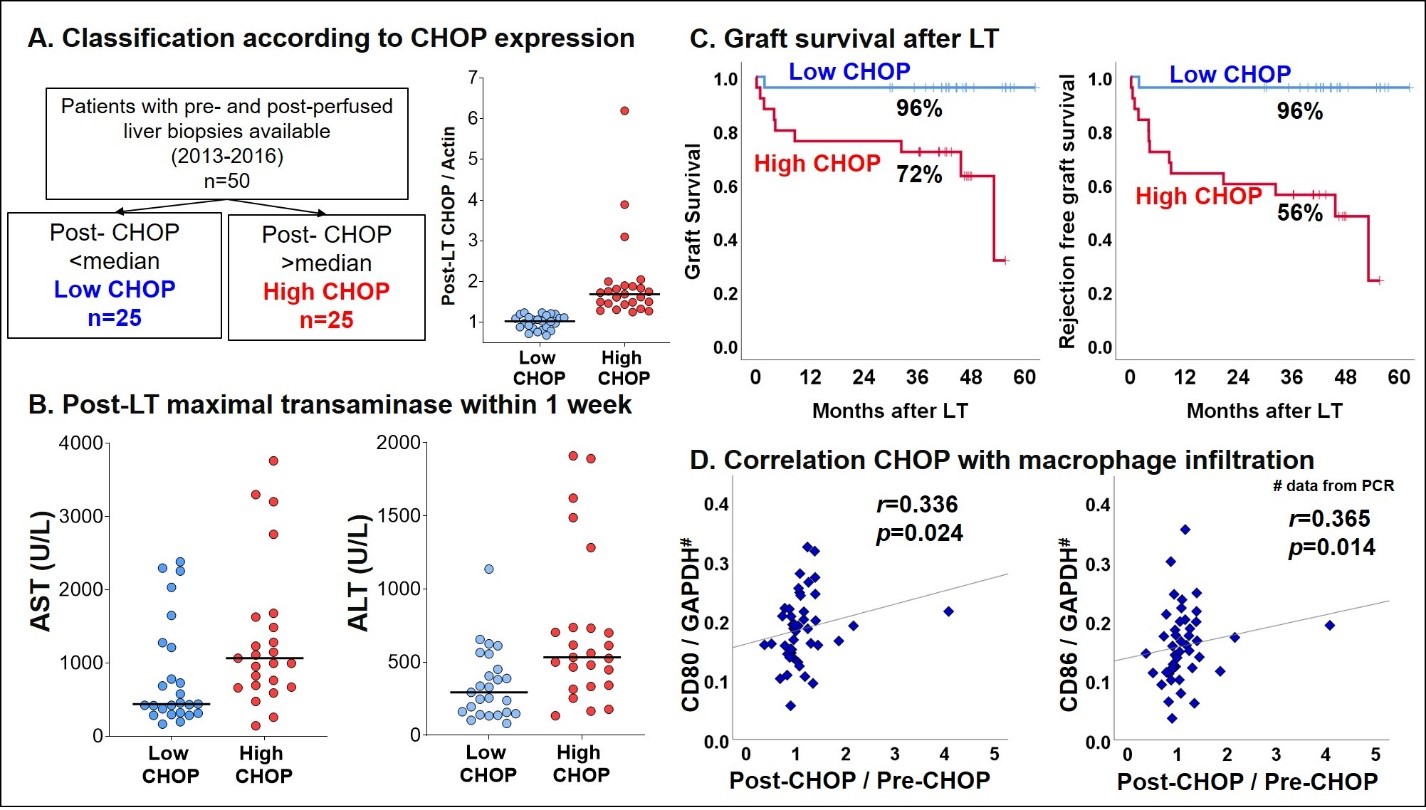Post-Transplant Hepatic CHOP Expression Dictates Clinical Outcomes in Liver Transplantation
1UCLA, Los Angeles, CA, 2Kyoto University, Kyoto, Japan
Meeting: 2020 American Transplant Congress
Abstract number: 413
Keywords: Graft failure, Graft function, Graft survival, Liver transplantation
Session Information
Session Name: Biomarkers, Immune Assessment and Clinical Outcomes IV
Session Type: Oral Abstract Session
Date: Saturday, May 30, 2020
Session Time: 3:15pm-4:45pm
 Presentation Time: 3:39pm-3:51pm
Presentation Time: 3:39pm-3:51pm
Location: Virtual
*Purpose: Endoplasmic reticulum (ER) stress plays a pivotal role in the mechanism of liver ischemia reperfusion injury (IRI). Although we and others have demonstrated the benefit of ER stress modulation against hepatic IRI in animal models, its impact in human liver transplantation (LT) remains unknown. This study was aimed to assess as to whether and how CCAAT-Enhancer-Binding Protein Homologous Protein (CHOP), a marker of ER stress, may affect clinical outcomes in LT patients.
*Methods: Fifty primary human LT grafts were analyzed retrospectively under IRB protocol (2013-2016, single center). Protocol Tru-Cut needle biopsies (Bx) were obtained after liver cold storage at back table; and post-transplant Bx were collected 2h after portal reperfusion. The fifty LT cases were then classified based on Western-assisted CHOP expression into two groups by median split, i.e., low CHOP and high CHOP group (n=25/group). The clinical parameters and outcomes, including MELD score, pre-LT hospital stay, transaminase release post-LT, pro-inflammatory gene expression profiles, and graft survival, were compared between the two groups.
*Results: Recipients in the high CHOP expression group had significantly lower physiological MELD scores at the time of LT (22 vs 40, p=0.003) and shorter pre-LT hospital stay (1 vs 12 days, p=0.005) as compared to those in the low CHOP expression group. However, notably, high CHOP group had significantly higher post-LT transaminase levels [maximal within first week after LT (AST: 1066 vs 439 U/L, p=0.010; ALT: 533 vs 294 U/L, p=0.002) / AST on POD 0 and 1 (p<0.05) / ALT on POD 0 to 4]; and higher incidence of acute rejection (AR) (16 vs 0 %, p=0.037). In addition, post-LT CHOP expression showed positive correlation with maximal AST/ALT levels by Spearman test (AST: r=0.325, p=0.021; ALT: r=0.447, p=0.001). Moreover, the relative ratio of CHOP expression from pre- to post-perfusion LT was positively correlated with macrophage infiltration in post-reperfusion liver Bx (CD80: r=0.336, p=0.024, CD86: r=0.365, p=0.014). Of note, by 3 years post-LT, patients with high CHOP expression exhibited significantly inferior graft survival (72% vs 96%, p=0.004) and AR-free graft survival (56% vs 96%, p<0.001).
*Conclusions: CHOP expression in post-LT biopsies significantly correlated with hepatocellular graft function, proinflammatory phenotype and rejection-free graft survival. Thus, CHOP can potentially serve as a novel biomarker of hepatocellular function and clinical outcomes in human LT patients.
To cite this abstract in AMA style:
Hirao H, Ito T, Nakamura K, Kageyama S, Kadono K, Kojima H, Dery KJ, Younan S, Busuttil RW, Kaldas FM, Kupiec‐Weglinski JW. Post-Transplant Hepatic CHOP Expression Dictates Clinical Outcomes in Liver Transplantation [abstract]. Am J Transplant. 2020; 20 (suppl 3). https://atcmeetingabstracts.com/abstract/post-transplant-hepatic-chop-expression-dictates-clinical-outcomes-in-liver-transplantation/. Accessed December 19, 2025.« Back to 2020 American Transplant Congress

